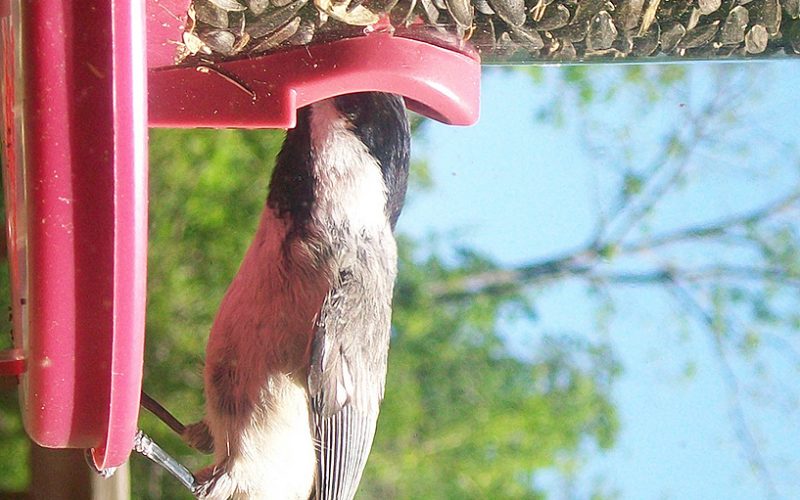The chickadee in the picture eluded my camera for over two weeks until I finally caught it with its beak in the cookie jar. Our native and migrant populations of birds offer endless hours of entertainment, especially if given a reason to fly right up to your kitchen window for a snack. Using chickadees as an example, here are some ideas for how to follow Mary Poppin’s advice and “feed the birds” without spending too many tuppence.
The chickadee is a tiny, year-round resident of Arkansas that nests in cavities or nest boxes. One chickadee needs to eat the energy equivalent of 250 sunflower seeds a day, so this explains why they’re constantly flitting to and from the birdfeeder! Black oil sunflower seeds are a favorite snack, although they mainly feed on insects. Concerned about birds becoming dependent on your feeder? Don’t be — the National Wildlife Federation, based on research from the University of Wisconsin, explains that chickadees can find wild food even if they feed at a birdfeeder and even if that birdfeeder is later removed. But chickadees’ survival rates get a boost during harsh winters if they receive supplemental nutrition from a birdfeeder.
Which feeder should you buy? Well, maybe none! You could make your own birdfeeder from a recycled soda bottle or scrap lumber. It’s best to make the feeders as non-toxic as possible, though, so leave it a natural color instead of giving it a resemblance to a rainbow. That goes for hummingbird nectar, too. Artificial dyes and sweetners aren’t good for hummingbirds, so let your red feeder do the attracting, not red-colored nectar. If you do want to purchase a feeder, there are hundreds of options online and plenty of cute and functional choices locally at the Fayetteville Farmer’s Co-op.
Nightbird Books has a great how-to guide for building houses and feeders for your backyard birds. If your child (or inner child) is a chickadee fan, check out Chickadees At Night, a book with rhythmic humor written by Bill O. Smith. To survive their nightly fast, they stuff themselves during the day to generate enough heat to last through the night, shed their feathers at the end of summer to grow new ones just before winter, and locate small, single-bird roosting holes in tree trunks. Your birdfeeder helps keep them alive at night, especially during winter.
Of course, the best way to feed the birds is to let nature do it for you. Creating a backyard habitat with native plants can provide shelter, nesting sites, and food for the birds in the form of insects and berries. These native plants support the native insects our native birds depend on — it’s one big chain, and every link can be a source of joy year-round!
Ripples is a blog connecting people to resources on sustainable living while chronicling their off-grid journey and supporting the work of non-profit organizations. Read more on this topic and others at www.RipplesBlog.org











